| Pages:
1
2
3
4
5 |
mnick12
Hazard to Others
  
Posts: 404
Registered: 30-12-2009
Location: In the lab w/ Dr. Evil
Member Is Offline
Mood: devious
|
|
No I dont think so remember vanillin is already an aldehyde take a look on wiki http://en.wikipedia.org/wiki/Vanillin. The fully reduced vanillin would be 2-methoxy-4-methylphenol. But that could be converted into an aldehyde
a number of ways if you really wanted to.
|
|
|
DJF90
International Hazard
    
Posts: 2266
Registered: 15-12-2007
Location: At the bench
Member Is Offline
Mood: No Mood
|
|
Actually you're not gonna get rid of that oxygen so easily so it'll really be 2-methoxy-4-methylbenzyl alcohol.
|
|
|
organometallic
Hazard to Self
 
Posts: 53
Registered: 22-7-2007
Location: United Kingdom
Member Is Offline
Mood: No Mood
|
|
Sorry if I'm wrong but surely it'll be 3-methoxy-4-hydroxy benzyl alcohol?
quoting nicodem: 'Note they claim p-hydroxybenzaldehyde reduces to p-hydroxybenzyl alcohol using 1 equivalent of thiourea dioxide.' sorry if im
wasting your time though i just dont see how it would convert the hydroxy to a methyl group, that involves adding a carbon somehow...
In vials of ivory and coloured glass
Unstoppered, lurked her strange synthetic perfumes,
Unguent, powdered, or liquid - troubled, confused
And drowned the sense in odours.
|
|
|
DJF90
International Hazard
    
Posts: 2266
Registered: 15-12-2007
Location: At the bench
Member Is Offline
Mood: No Mood
|
|
I was correcting the product that mnick12 gave. I failed to notice that he had misnamed the product from vanillin. However you yourself suggested the
dihydroxyaldehyde would be obtained. That ain't gonna happen either. Need a strong lewis acid to do that.
[Edited on 13-6-2010 by DJF90]
|
|
|
organometallic
Hazard to Self
 
Posts: 53
Registered: 22-7-2007
Location: United Kingdom
Member Is Offline
Mood: No Mood
|
|
O.K noted, so it won't convert the phenolic -OH to a methyl then as well :]
How likely is is that TUD could be used to hydrogenate the double bond on a nitrostyrene, or maybe convert say phenyl-2-nitropropene to
phenyl-2-nitropropane, or all the way to amphetamine?
What about the corresponding nitrostyrene for 2c-b or mescaline?
It occured to me, do the other ring substituents on the nitrostyrenes derived from 2,5-dimethoxybenzaldehyde and 3,4,5-trimethoxybenzalehyde
contribute any electron density to the double bond in the nitrostyrene, making it harder to hydrogenate that for straight benzaldehyde?
[Edited on 14-6-2010 by organometallic]
In vials of ivory and coloured glass
Unstoppered, lurked her strange synthetic perfumes,
Unguent, powdered, or liquid - troubled, confused
And drowned the sense in odours.
|
|
|
Lambda-Eyde
National Hazard
   
Posts: 857
Registered: 20-11-2008
Location: Norway
Member Is Offline
Mood: Cleaved
|
|
Is this really a forum where it is allowed to openly discuss the synthesis of amphetamines? I thought this was a forum for people who embrace
chemistry as a hobby.
Oh, and please spare me for the libertarian crap and the excuse that "it's allowed as long as it is scientific".
|
|
|
DJF90
International Hazard
    
Posts: 2266
Registered: 15-12-2007
Location: At the bench
Member Is Offline
Mood: No Mood
|
|
It's fucking ridiculous isn't it...
|
|
|
Barium
Hazard to Self
 
Posts: 85
Registered: 24-8-2008
Member Is Offline
Mood: No Mood
|
|
Organometallic, TUD won't hydrogenate anything, but it can reduce various functionalities. Learn the difference between reduction and
hydrogenation/hydrogenolysis. Wery few things will selectively attack the double bond in a beta-nitrostyrene and I strongly doubt TUD is one of those.
It might very well reduce a nitrostyrene to the oxime though.
|
|
|
zed
International Hazard
    
Posts: 2277
Registered: 6-9-2008
Location: Great State of Jefferson, City of Portland
Member Is Offline
Mood: Semi-repentant Sith Lord
|
|
Likewise, the direct reduction of Nitro-Propenyl Benzenes to Amines, is quite difficult.
LiAlH4 can achieve that objective, and very few other things. Just figure that all reagents that are inexpensive, easy to obtain, and safe to
handle......Will fail.
Perhaps you would benefit from a few days of pouring through the archives. Just read through string after string, of vaguely related material. There
is a lot of very exotic information on Science Madness, but much of it....is tucked away in odd places.
---------------------------------------------------------
Methinks the lady doth protest too much!
|
|
|
peach
Bon Vivant
    
Posts: 1428
Registered: 14-11-2008
Member Is Offline
Mood: No Mood
|
|
| Quote: | amphetamine?
What about the corresponding nitrostyrene for 2c-b or mescaline? |
I appreciate where you're coming from, but going that far with naming specific drugs as targets is a bad plan on this forum.
Saying that, two stickied topics are preparing benzaldehyde and acetic anhydride.
| Quote: | | LiAlH4 can achieve that objective, and very few other things. |
That's the hinky dinky stuff someone was selling kilos of on here whilst not collecting any information from his buyers. Silly boy.
[Edited on 21-6-2010 by peach]
|
|
|
manimal
Hazard to Others
  
Posts: 180
Registered: 15-1-2008
Member Is Offline
Mood: ain't even mad
|
|
Quote: Originally posted by Nicodem  |
* There are plenty of papers claiming this reagents reduces nitroaromatics to anilines under similar conditions. Besides, my BS detector goes wild in
such cases due to the unfortunate frequency of fictional papers coming from India&Iran&Co. combined with certain weird things of which maybe
the weirdest one is the oxygen content measured with an elemental analysis! Besides, the products are known compounds and they don't even give melting
points and back them up with references. Another improper thing is in that they did not include any references for the nitroaromatics being reduced
with thiourea dioxide. I'm sorry to say this, but whoever was the peer reviewer for this paper truly did a very lousy job. |
Checkout this article that states that 60% of Chinese PhD candidates admit to plagiarism and bribery: http://www.csmonitor.com/2006/0516/p01s03-woap.html
|
|
|
turd
National Hazard
   
Posts: 800
Registered: 5-3-2006
Member Is Offline
Mood: No Mood
|
|
Quote: Originally posted by zed  | Likewise, the direct reduction of Nitro-Propenyl Benzenes to Amines, is quite difficult.
LiAlH4 can achieve that objective, and very few other things. Just figure that all reagents that are inexpensive, easy to obtain, and safe to
handle......Will fail.
|
???
http://www.erowid.org/archive/rhodium/chemistry/nitrostyrene...
Needless to say, small scale rocks. 
|
|
|
mnick12
Hazard to Others
  
Posts: 404
Registered: 30-12-2009
Location: In the lab w/ Dr. Evil
Member Is Offline
Mood: devious
|
|
Well I got some vanillin a while ago, and if I have the time tomorrow I will make some more TUD and try reducing some vanillin. If I do not have
enough time I will finish it up later in the week.
Stay tuned.
|
|
|
UnintentionalChaos
International Hazard
    
Posts: 1454
Registered: 9-12-2006
Location: Mars
Member Is Offline
Mood: Nucleophilic
|
|
Hey look, someone (me) actually used TUD for something! I reduced 3-nitrophthalhydrazide to luminol, which is a reduction of an aromatic nitro group.
So, not the most impressive demo of reducing power, but it's something:
http://youtu.be/-PGtoZEZnzc
Reduction at 3:34
Glowing stuff at 19:33
Department of Redundancy Department - Now with paperwork!
'In organic synthesis, we call decomposition products "crap", however this is not a IUPAC approved nomenclature.' -Nicodem
|
|
|
AndersHoveland
Hazard to Other Members, due to repeated speculation and posting of untested highly dangerous procedures!
    
Posts: 1986
Registered: 2-3-2011
Member Is Offline
Mood: No Mood
|
|
NaBH4 supposedly can reduce picric acid to 1,3,5-trinitropentane.
M. Adam and T. Severin, Chem. Ber. Volume 96, p448. (1963)
The reaction is also mentioned in another paper, which mentions both microbial reduction and reduction with borohydride:
http://aem.asm.org/cgi/reprint/58/9/2933.pdf
Do you think thiourea dioxide is too strong of a reducing agent for the reaction?
[Edited on 17-7-2011 by AndersHoveland]
I'm not saying let's go kill all the stupid people...I'm just saying lets remove all the warning labels and let the problem sort itself out.
|
|
|
Magpie
lab constructor
    
Posts: 5939
Registered: 1-11-2003
Location: USA
Member Is Offline
Mood: Chemistry: the subtle science.
|
|
I would like to be able to reduce ketones/aldehydes but have no NaBH4. I've been wondering if thiourea dioxide would be capable of reducing
cyclohexanone. Based on the following excerpt it looks like it may be possible. What do you think?
excerpt from a University of Warwick PhD thesis, February 2008 by James Frederick Shuan-Liang
Reduction of 4-tert-Butylcyclohexanone with Thiourea dioxide
Experimental
"4-tert-butylcyclohexanone (463 mg, 3 mmol) was added to a solution of the thiourea dioxide and sodium hydroxide in ethanol (6ml) and water (4 ml) and
heated to 78 ºC under a nitrogen atmosphere for 4 h. The reaction mixture was cooled to RT and acidified with 2 M hydrochloric acid. The white
suspension was partitioned over diethyl ether, filtered and separated. The aqueous layer was extracted with diethyl ether and all organic media
combined, dried (sodium sulfate), filtered and concentrated to an off-white solid. Purification was achieved via flash chromatography (silica, 20 g)
with n-pentane and 10–25% diethyl ether/n-pentane to afford the cis and the trans-diastereoisomers of 4-tert-butylcyclohexanol as a white wool.
•Thiourea dioxide(648 mg, 2 equiv.) and sodium hydroxide (480 mg, 4 equiv.) gave the alcohol (211 mg, 45%, 3:97cis:trans)."
[Edited on 22-3-2013 by Magpie]
The single most important condition for a successful synthesis is good mixing - Nicodem
|
|
|
paw_20
Harmless

Posts: 32
Registered: 14-8-2012
Location: United States
Member Is Offline
Mood: Curious
|
|
I don't see why it wouldn't reduce cyclohexanone Magpie that t-butyl group shouldn't make a difference in the 4 position
|
|
|
Magpie
lab constructor
    
Posts: 5939
Registered: 1-11-2003
Location: USA
Member Is Offline
Mood: Chemistry: the subtle science.
|
|
I am attempting to reduce 10mL of cyclohexanone to cyclohexanol with thiourea dioxide. The reaction is being conducted at reflux (~78°C) in ethanol
with some water and NaOH added. Reaction time so far is 2 hours and may continue for another 2 hours.
Thiourea dioxide is also known as aminomethane sulfinic acid.
(-NH2)(=NH)C-S(=O)(-OH)
There was a great deal of white solids formed early from a clear charge. There does not seem to be any gases generated as I have it contained with a
balloon filled with argon.
Does anyone know what are the likely by-products?
I really don't want to make a separation using diethyl ether. Perhaps dichloromethane can be used instead?
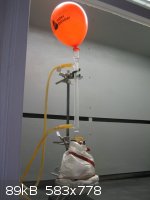
[Edited on 27-3-2013 by Magpie]
[Edited on 27-3-2013 by Magpie]
The single most important condition for a successful synthesis is good mixing - Nicodem
|
|
|
Nicodem
Super Moderator
      
Posts: 4230
Registered: 28-12-2004
Member Is Offline
Mood: No Mood
|
|
All byproducts from the reagents are washed away by water or diluted brine (urea, higher sulfates, etc.) so you don't have to worry about it.
Depending on how much cosolvent you used, you could just dilute with 10 ml of about 10% brine, wash the crude product with saturated brine, dry over
Na2SO4 and distill. You can use some dichloromethane to reduce the mechanical losses, but I would not bother using it for an
extraction as it really isn't necessary. If you used a relatively large amount of ethanol, it might be best to first remove it by carefully rotavaping
or distilling it off directly from the reaction mixture (don't exaggerate so you don't loose the product as well).
Due to the miniscale you are using, any of this might not be reasonable, if all you need is to check if the reaction works or not. But essentially you
only need to get about a mL of a distillate for a bp determination and check the yields at a larger scale experiment where the mechanical losses will
be less notable. You will also be able to fractionate and thus obtain a purer product at a larger scale. A problem you might encounter will be the
uncertainty of the identification due to the close bp of cyclohexanol and cyclohexanone, especially if you get a mixture of the two due to incomplete
conversion. If you have 2,4-dinitrophenylhydrazine, you might check for the presence of cyclohexanone by derivatization and TLC.
…there is a human touch of the cultist “believer” in every theorist that he must struggle against as being
unworthy of the scientist. Some of the greatest men of science have publicly repudiated a theory which earlier they hotly defended. In this lies their
scientific temper, not in the scientific defense of the theory. - Weston La Barre (Ghost Dance, 1972)
Read the The ScienceMadness Guidelines!
|
|
|
Magpie
lab constructor
    
Posts: 5939
Registered: 1-11-2003
Location: USA
Member Is Offline
Mood: Chemistry: the subtle science.
|
|
Thanks Nicodem for your comments. I apologize for not providing a more complete description of my procedure. Here's the details:
So far what I have done is to scale this reaction up by a factor of 32.1 based on the information in the Shuan-Liang thesis referenced above.
So, just for a charge of 10mL of cyclohexanone the following were added: 95% ethanol, 193mL; H2O, 129mL; NaOH, 15.4g; TUD, 20.8g. After 4 hours at
reflux I turned off the heat and left it overnight. That's where I am right now.
The thesis then says to acidify with 2M HCl, which I have calculated may be up to as much as 193mL. The next step is to "partition" with ether,
filter both phases, extract the aqueous with more ether, combine the ethers, dry them with Na2SO4, then concentrate to an off-white solid. This solid
is then purified by flash chromatography.
I won't be doing the flash chromatography. But the rest of this procedure seems reasonable and doable by me. I just don't like preparing and handling
ether. But I will do what is necessary. My goal is to get as much yield as possible. Without doing any calculations the theoretical yield should be
~10g I would think.
The single most important condition for a successful synthesis is good mixing - Nicodem
|
|
|
Nicodem
Super Moderator
      
Posts: 4230
Registered: 28-12-2004
Member Is Offline
Mood: No Mood
|
|
Quote: Originally posted by Magpie  | So far what I have done is to scale this reaction up by a factor of 32.1 based on the information in the Shuan-Liang thesis referenced above.
So, just for a charge of 10mL of cyclohexanone the following were added: 95% ethanol, 193mL; H2O, 129mL; NaOH, 15.4g; TUD, 20.8g. After 4 hours at
reflux I turned off the heat and left it overnight. That's where I am right now. |
You shouldn't scale-up a 3 mmol reaction by factoring up like that for a few reasons. Firstly, at 3 mmol it is the tendency of all organic synthetic
chemists to use a much more diluted reaction mixture from what would be considered optimal (by the rule of thumb one initially uses 10 mL of a solvent
for each gram of the substrate if the scale of the not-yet-optimized reaction is more than about 20 mmol). Secondly, your substrate requires much less
cosolvent as its logP is significantly lower than that of 4-t-butylcyclohexanone. Ideally, for something like cyclohexanone, you could check
the reaction in the absence of a cosolvent. Less ideally, the kinetics would be too slow in the absence of a cosolvent, but a minimum of 1 : 6 : 2
ratio of cyclohexanone vs. ethanol vs. NaOH(aq) volumes should give you a biphasic or even monophasic mixture with excellent partitioning enabling for
good reaction kinetics and easy work up. The ratio could be potentially lowered to 1 : 3 : 1 by reducing the excess of thiourea dioxide and NaOH.
Thirdly, when setting up reactions it is always good to consider how will the amount of solvents and reagents influence the work up.
To get back on the work up of this specific reaction mixture, I suggest you to concentrate to a volume of about 150-170 mL by distilling off the
ethanol using a short Vigreux or another simple column to prevent loosing the relatively small amount of the product with steam/ethanol. Then saturate
with NaCl and extract with about 20 mL dichloromethane, wash the extract with 50 mL water, remove the solvent and make a short path distillation to
remove the nonvolatiles. This should give you a crude product that can be tested for its bp. Due to the short path distillation, it could remain
contaminated with some residual ethanol which can give you a false negative from the bp determination.
| Quote: | | I won't be doing the flash chromatography. |
It is not really feasible for something as volatile as cyclohexanol anyway.
| Quote: | | I just don't like preparing and handling ether. But I will do what is necessary. |
You don't need to. Dichloromethane will do just fine and if you remove most of the ethanol and use NaCl like I suggested, you wont need to do multiple
extractions either. Considering the logP of cyclohexanol, one extraction will be enough (actually, the cyclohexanol should already oil out upon
saturation with NaCl).
Also, the neutralization with HCl in the original procedure is obsolete and an optimized reaction would probably not necessitate for a triple excess
of thiourea dioxide and NaOH. It is possible that a 50% excess works just well. And Na2CO3 or K2CO3 instead of NaOH might also perform equally well or
better.
Edit: Reconsidered a few things.
[Edited on 27/3/2013 by Nicodem]
…there is a human touch of the cultist “believer” in every theorist that he must struggle against as being
unworthy of the scientist. Some of the greatest men of science have publicly repudiated a theory which earlier they hotly defended. In this lies their
scientific temper, not in the scientific defense of the theory. - Weston La Barre (Ghost Dance, 1972)
Read the The ScienceMadness Guidelines!
|
|
|
Magpie
lab constructor
    
Posts: 5939
Registered: 1-11-2003
Location: USA
Member Is Offline
Mood: Chemistry: the subtle science.
|
|
Thanks for the insight and rule-of-thumb for regular scale reactions. Before setting up the reaction I did think about scaling back on the
solvent/co-solvent. But after the reaction proceeded for not very long a great deal of white solids appeared. In fact so much, that bumping became
an issue. I shut down twice to first add boiling stones then to add a magnetic stir bar. Bumping was mitigated but never went away.
Should I go a head and acidify with the 2M HCl before proceeding?
Edit: I see your reconsiderations. Thanks.
[Edited on 27-3-2013 by Magpie]
The single most important condition for a successful synthesis is good mixing - Nicodem
|
|
|
Magpie
lab constructor
    
Posts: 5939
Registered: 1-11-2003
Location: USA
Member Is Offline
Mood: Chemistry: the subtle science.
|
|
Would it be best to heat the batch up to try to liquify it and then try to filter out all those solids before proceeding?
Or, perhaps it would be best to start over rather than possibly wasting dichloromethane on the extraction. I have 9mL of cyclohexanone left and
plenty of the other reagents.
The single most important condition for a successful synthesis is good mixing - Nicodem
|
|
|
Magpie
lab constructor
    
Posts: 5939
Registered: 1-11-2003
Location: USA
Member Is Offline
Mood: Chemistry: the subtle science.
|
|
Here is a picture of the post reaction mix. It doesn't look as solids-laden as I had imagined. So will proceed per your recommendations, Nicodem.
That's a 1000mL RBF, BTW.
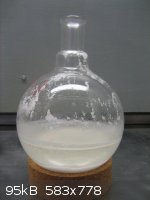
[Edited on 27-3-2013 by Magpie]
The single most important condition for a successful synthesis is good mixing - Nicodem
|
|
|
Magpie
lab constructor
    
Posts: 5939
Registered: 1-11-2003
Location: USA
Member Is Offline
Mood: Chemistry: the subtle science.
|
|
Here's a summary of today's work, with pictures of the reaction product workup for cyclohexanol from alkaline (pH=8.5) aqueous ethanol (60% alcohol).
The reaction product was first filtered to remove the white solids: about 20g by eye (see picture below). The yellow tinged transparent filtrate was
then distilled using a jury-rigged short path column, also shown below. There is about 3" of loose ss scrub pad in the column. The final picture
shows the results of the distillation. Note that a thin layer of oil can be seen floating on the pot residue. Tomorrow this residue will be
saturated with NaCl then extracted with dichloromethane per Nicodem's guidance.
The products have a strange sulfurous smell. Sometimes a trace of H2S is present, but mostly it is like smelling SO2. Most of this odor left when
the filter cake was removed from the lab.
============================
Edit: Today I realized what the by-products smell like: urine. This makes sense considering the composition of TUD.
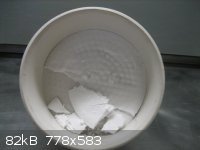 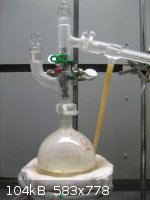
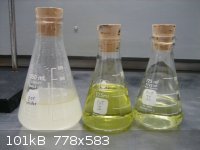
[Edited on 28-3-2013 by Magpie]
[Edited on 28-3-2013 by Magpie]
[Edited on 28-3-2013 by Magpie]
The single most important condition for a successful synthesis is good mixing - Nicodem
|
|
|
| Pages:
1
2
3
4
5 |